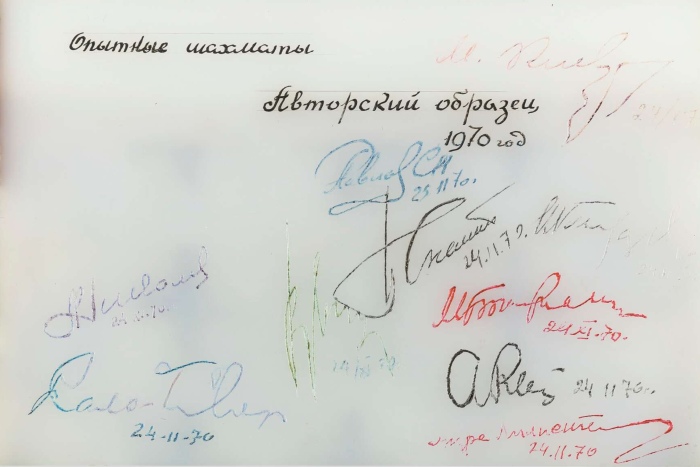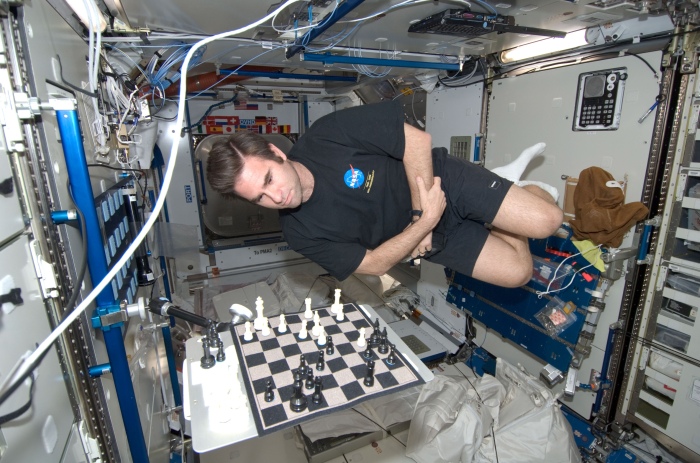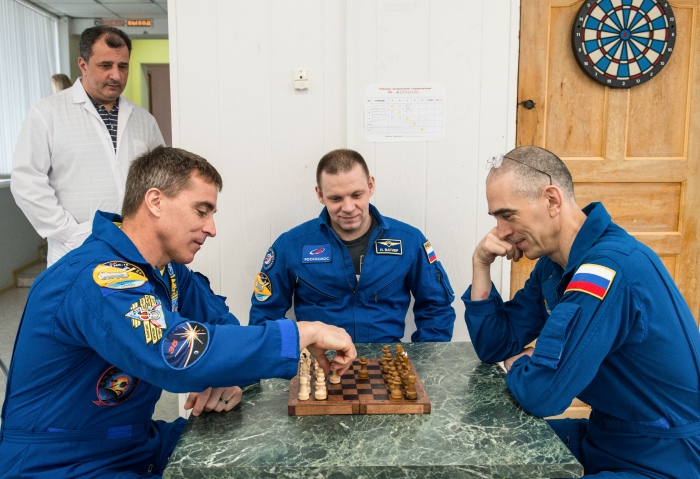Today is the International Day of Human Space Flight (#HumanSpaceFlight), held on April 12 to commemorate the first space flight by Yuri Gagarin, in 1961. In this picture Yuri Gagarin, Grigory Nelyubov and Nikolai Kamanin are playing chess during the flight that took them to the Baikonur Cosmodrome, the legendary launching place in Kazakhstan from where the space exploration began. Seven days after this picture was taken, Gagarin would be leaving the atmosphere, starting a completely new chapter in the history of humankind.
Truth be told, Gagarin was not particularly interested in chess – no more than the average Russian person. But nevertheless, chess was one of the very first human leisure activities brought to space by the cosmonauts. The set on this photo was carried aboard the Soyuz 3 and 4 capsules in 1968-1969. Magnetic pieces are not allowed on zero-gravity environments, because they could end up in unexpected places where they would interfere with the on-board instruments. The Soviets designed special chess sets, with pegs and grooves to keep the pieces in place.
 Photo: Chad Cullen / National Air and Space Museum, Washington.
Photo: Chad Cullen / National Air and Space Museum, Washington.
In June 1970 the Soviet astronauts Andrian Nikolayev (Mission Commander) and Vitaly Sevastyanov (Flight Engineer), who were aboard the Soyuz 9 spacecraft, played a consultation game against the earthbound Viktor Gorbatko (also an astronaut) and Nikolai Kamanin (Soviet general, and head of the astronaut training program).
Sevastyanov and Nikolayev spent 18 days in space, a record at the time. Their mission was used to investigate the social and psychological implications of prolonged spaceflight. The zero-gravity chess board that they used, signed by the two cosmonauts as well as Boris Spassky (at that time the world champion), Mikhail Botvinnik, Igor Bondarevsky, Alexander Kotov, Salo Flohr, and Andor Lilienthal, was sold by Sotheby’s in 2018 for $1,250.

 Photos: Sotheby’s
Photos: Sotheby’s
Vitaly Sevastyanov was an avid chess fan – so much so, that he would later become President of the Soviet Union Chess Federation from 1977 to 1986 and from 1988 to 1989. He played a very important role during those years when chess was still dominated by the Soviet players.
 Photo: Sputnik / Alamy Stock Photo
Photo: Sputnik / Alamy Stock Photo
Not only the Soviet cosmonauts took chess to outer space. Many of their American counterparts, the astronauts, were also keen players. For instance, the first man to walk on the moon, Neil Armstrong (1930-Aug 25, 2012) was a chess fan. In his biography by Leon Wagener (“One Giant Leap”), the author reveals that Neil played chess with his six-year-old son Mark, while he was quarantined upon his return from the Moon.
Contrary to the Russians, the Americans didn’t come up with special designs for zero-gravity chess boards. Instead, they resorted to simple plastic pieces fitted with velcro. That’s what the NASA Astronaut Greg Chamitoff did in 2018 in order to take a chess set with him on the space shuttle. In August 2018 he played a chess match against Houston Mission Control and won two games against ground control while playing from the International Space Station (ISS).
 Photo: NASA.
Photo: NASA.
In 2008, NASA and the US Chess Federation teamed up to host a match between the astronaut and Earth. The USCF coordinated worldwide voting on the Earth’s moves, which were proposed by the K-3 champions, the Chess Club at Stevenson Elementary School in Bellevue, Wash.
In honor of Human Space Flight Day and of the half-century anniversary of the Cosmos-Earth chess game (which took place on June 9, 1970), Roscosmos State Corporation for Space Activities, Chess Federation of Russia and Moscow Museum of Cosmonautics organize an online chess tournament among schoolchildren. The games will be played on chessplanet.ru on April 18. Info and registration (in Russian):
Ivanishin (right) is seen on this picture playing chess with his colleague Chris Cassidy (left), at the Cosmonaut Hotel crew quarters at the Baikonur Cosmodrome in Kazakhstan (the same place from where Gagarin took off), a few days before the launch took place.
 Photo: Andrey Shelepin/Gagarin Cosmonaut Training Center.
Photo: Andrey Shelepin/Gagarin Cosmonaut Training Center.
If you happen to leave in Missouri, you are still on time to visit the exhibition “Ground Control: A Journey Through Chess and Space“, at the World Chess Hall of Fame. The exhibition is on view until April 26.
The links between chess and space exploration demonstrate that the game of chess – and other strategy games – are intrinsic to humankind. They are part of our culture, and one of the oldest forms of human social interaction.

